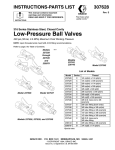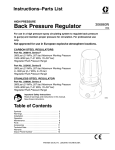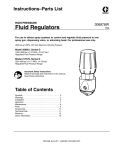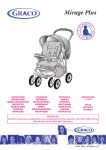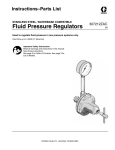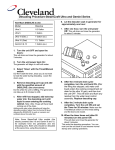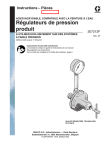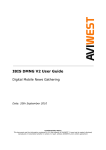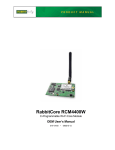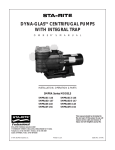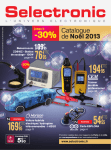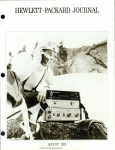Download Graco 307707ZAP User's Manual
Transcript
Instructions–Parts List HIGH–FLO SERIES 307707ZAP Surge Tanks ENG These tanks reduce fluid surging in a high– or medium–volume, low–pressure fluid system. For professional use only. Important Safety Instructions Read all warnings and instructions in this manual. Save these instructions. Model 220157, Series E on Surge Tank Stand Kit 218742 7139A Model 238983, Series C on Surge Tank Stand Kit 218742 7287B Model 233736, Series A TI1898B Table of Contents Warnings . . . . . . . . . . . . . . . . . . . . . . . . . . . . . . . . . . . . . . 3 Installation All Models . . . . . . . . . . . . . . . . . . . . . . . . . . . . . . . . . . 5 Models 238983, 238984, 238985, 238986, 238987, 238988, 218509, and 220157 . . 6 Model 233736 . . . . . . . . . . . . . . . . . . . . . . . . . . . . . . . 8 Operation All Models . . . . . . . . . . . . . . . . . . . . . . . . . . . . . . . . . . 9 Models 238983, 238984, 238985, 218509, 238985, 238986, 238987, 238988, and 220157 . 10 Model 233736 . . . . . . . . . . . . . . . . . . . . . . . . . . . . . . 12 Troubleshooting . . . . . . . . . . . . . . . . . . . . . . . . . . . . . . . 13 Service Models 218509, 220157 . . . . . . . . . . . . . . . . . . . . . 14 Models 238983, 238984, 238985 . . . . . . . . . . . . . 15 Model 233736 . . . . . . . . . . . . . . . . . . . . . . . . . . . . . . 16 Parts Drawings and Lists Model 218509 . . . . . . . . . . . . . . . . . . . . . . . . . . . . . . Model 220157 . . . . . . . . . . . . . . . . . . . . . . . . . . . . . . Models 238983, 238984, 238985, 238986, 238987, 238988 . . . . . . . . . . . . . . . . . . . . . . . . . . . . Model 233736 . . . . . . . . . . . . . . . . . . . . . . . . . . . . . . Dimensional Drawings . . . . . . . . . . . . . . . . . . . . . . . . . Stand Mounting Hole Layout . . . . . . . . . . . . . . . . . . . . Technical Data . . . . . . . . . . . . . . . . . . . . . . . . . . . . . . . . Warranty . . . . . . . . . . . . . . . . . . . . . . . . . . . . . . . . . . . . . Graco Information . . . . . . . . . . . . . . . . . . . . . . . . . . . . . List of Models Maximum Fluid Working Pressure Part No. Series Description 238983, 238986 C High volume, electropolished stainless steel, 2 npt(f) inlet and outlet 238984, 238987 C High volume, electropolished stainless steel, 2 in. sanitary 300 psi (2.1 MPa, 21 bar) inlet and outlet (Tri–Clamp compatible) 238985, 238988 C High volume, electropolished stainless steel, 1.5 in. sanitary inlet and outlet (Tri–Clamp compatible) 300 psi (2.1 MPa, 21 bar) 233736 A High volume, stainless steel, 1/4 bspp(f) air port, 3/4 bspp(f) fluid port 360 psi (2.5 MPa, 25 bar) 218509 E High volume, carbon steel, 2 npt(f) inlet and outlet 600 psi (4.2 MPa, 42 bar) 220157 E Medium volume, electropolished stainless steel, 1.25 npt(f) inlet, 1.25 npt(f) outlet 600 psi (4.2 MPa, 42 bar) A Surge Tank Stand Kit (not used with Part No. 233736) n/a 300 psi (2.1 MPa, 21 bar) Accessory 218742 2 307707 17 18 19 20 21 22 23 24 24 Symbols Warning Symbol Caution Symbol WARNING CAUTION This symbol alerts you to the possibility of serious injury or death if you do not follow the instructions. This symbol alerts you to the possibility of damage to or destruction of equipment if you do not follow the instructions. WARNING EQUIPMENT MISUSE HAZARD Equipment misuse can cause the equipment to rupture or malfunction and result in serious injury. INSTRUCTIONS This equipment is for professional use only. Read all instruction manuals, tags, and labels before operating the equipment. Use the equipment only for its intended purpose. If you are not sure, call your Graco distributor. Do not alter or modify this equipment. Use only genuine Graco parts and accessories. Check equipment daily. Repair or replace worn or damaged parts immediately. Do not exceed the maximum working pressure of the lowest rated component in your system. See Technical Data on page 23. Use fluids and solvents that are compatible with the equipment wetted parts. Refer to the Technical Data section of all equipment manuals. Read the fluid and solvent manufacturer’s warnings. Route hoses away from traffic areas, sharp edges, moving parts, and hot surfaces. Do not expose Graco hoses to temperatures above 82C (180F) or below –40C (–40F). Wear hearing protection when operating this equipment. Do not lift pressurized equipment. Comply with all applicable local, state, and national fire, electrical, and safety regulations. PRESSURIZED EQUIPMENT HAZARD Spray from the gun, hose leaks or ruptured components can splash fluid in the eyes or on the skin and cause serious injury. Do not stop or deflect fluid leaks with your hand, body, glove or rag. Follow the Pressure Relief Procedure on page 9 when: you are instructed to relieve pressure; stop spraying; clean, check or service the equipment; and install or clean fluid nozzles. Do not point the spray gun at anyone or at any part of the body. Tighten all fluid connections before operating the equipment. Check the hoses, tubes and couplings daily. Replace worn, damaged or loose parts immediately. Permanently coupled hoses cannot be repaired; replace the entire hose. 307707 3 WARNING FIRE AND EXPLOSION HAZARD Improper grounding, poor ventilation, open flames or sparks can cause a hazardous condition and result in a fire or explosion and serious injury. Ground the equipment. See Grounding on page 5. If there is any static sparking or you feel an electric shock while using this equipment, stop pumping immediately. Do not use the equipment until you identify and correct the problem. Provide fresh air ventilation to avoid the buildup of flammable fumes from solvents or the fluid being pumped. Keep the work area free of debris, including solvent, rags, and gasoline. Electrically disconnect all equipment in the work area. Extinguish all open flames or pilot lights in the work area. Do not smoke in the work area. Do not turn on or off any light switch in the work area while operating or if fumes are present. Do not operate a gasoline engine in the work area. Never use 1.1.1–trichloroethane, methylene chloride, other halogenated hydrocarbon solvents or fluids containing such solvents in pressurized aluminum equipment. Such use could result in a chemical reaction, with the possibility of explosion. TOXIC FLUID HAZARD Hazardous fluid or toxic fumes can cause serious injury or death if splashed in the eyes or on the skin, inhaled, or swallowed. Know the specific hazards of the fluid you are using. Store hazardous fluid in an approved container. Dispose of hazardous fluid according to all local, state and national guidelines. Always wear protective eyewear, gloves, clothing and respirator as recommended by the fluid and solvent manufacturer. Graco does not manufacture or supply the reactive chemical components that may be used in this equipment and is not responsible for injury or property loss, damage, expense or claims (direct or consequential) that arise from the use of such chemical components. MOVING PARTS HAZARD Moving parts, such as the air motor piston in the pump, can pinch or amputate your fingers. Keep clear of all moving parts when starting or operating the pump. Before servicing this surge tank, follow the Pressure Relief Procedure on page 9 to prevent the equipment from starting accidentally. 4 307707 Installation All Models Grounding Ground the tank and the rest of your system. See Fire and Explosion Hazard on page 4. Static electricity is generated by the flow of fluid through the pump and hose, but it is dissipated through proper grounding. If every part of the spray system is not properly grounded, sparking may occur, and the system may become hazardous. Sparking may also occur when plugging in or unplugging a power supply cord. Sparks can ignite fumes from solvents and the fluid being sprayed, dust particles and other flammable substances, and can cause a fire or explosion and serious injury and property damage. If you experience any static sparking or feel even a slight shock while using this equipment, stop spraying immediately. Check for proper grounding of the entire system. Be sure you have corrected the problem before starting to spray again. Ground the pump and all other spray equipment used or located in the spray area. The following are minimum requirements for grounding a basic spray system. Your system may include other equipment or objects which must also be grounded. Always check your local electrical code for detailed grounding instructions. Be sure your system is connected to a true earth ground. Pump: Ground by using a ground wire and clamp as described in your separate pump instruction manual. Air compressors and hydraulic power supplies: Follow the manufacturer’s recommendations. All air and fluid lines: Use only grounded hoses with a maximum of 150 m (500 ft) combined hose length to ensure grounding continuity. See Hose Grounding Continuity on page 5. Surge tank: Connect a ground wire and clamp as shown in Fig. 1. Loosen the grounding screw (W). Insert one end of a 1.5 mm2 (12 ga.) minimum ground wire (Y) behind the grounding screw and tighten the screw securely. Connect the clamp end of the ground wire to a true earth ground. Order Part No. 222011 Ground Wire and Clamp. Spray gun: Obtain grounding through connection to a properly grounded fluid hose and pump. Object being sprayed: Ground according to local code. Fluid supply container: Ground according to local code. All solvent pails used when flushing must be grounded according to local code. Use only grounded metal pails, which are conductive. Do not place the pail on any non-conductive surface, such as cardboard or paper, which would interrupt grounding continuity. To maintain grounding continuity when flushing or relieving pressure, always hold a metal part of the gun firmly to the side of a grounded metal pail, then trigger the gun. W Y Fig. 1 Hose Grounding Continuity Proper hose grounding continuity is essential to maintaining a grounded spray system. Check the electrical resistance of your air and fluid hoses at least once a week. If your hose does not have a tag on it which specifies the maximum electrical resistance, contact the hose supplier or manufacturer for the maximum resistance limits. Use a resistance meter in the appropriate range for your hose to check the resistance. If the resistance exceeds the recommended limits, replace the hose immediately. An ungrounded or poorly grounded hose can make your system hazardous. Flushing Safety Before flushing, be sure the entire system and flushing pails are properly grounded, and be sure that pressure is relieved. See Grounding and Pressure Relief Procedure on page 9. 307707 5 Installation Models 238983, 238984, 238985, 238986, 238987, 238988, 218509, and 220157 NOTE: Refer to page 8 to install Model 233736. Installing the Tank Use Stand Kit 218742 to mount the tank to the floor. See the Stand Mounting Hole Layout on page 22. Secure the stand (B) to the floor with M19 (5/8 in.) bolts that engage at least 152 mm (6 in.) into the concrete floor to prevent the tank from tipping. Horizontal / Vertical Mounting All surge tanks can by mounted horizontally or vertically. NOTE: Model 220157 can be mounted vertically with the fluid direction flowing upward (with the fluid inlet at the bottom). Items J, K, and L (mentioned in the text below) are supplied with Stand Kit 218742. Secure the bracket (J) to the leg of the stand (B) with a screw (K). Notice the different bracket positions for the three tank sizes. Turn the bracket (J) with a wrench to align it with the bosses on the surge tank. Then secure the bracket to the tank with the screws (L). Fluid Inlet / Outlet Ports On high-volume models (218509, 238983, 238984, 238985, 238986, 238987, and 238988), either port may be used as the fluid inlet. The direction of fluid flow through these models does not affect the performance. See the Dimensional Drawings on page 21. CAUTION The inlet and outlet adapter fittings on Models 238983, 238984, and 238985 (Ref. No. 3 on page 20) use a non-standard thread to fit into the fluid cover (Ref. No. 1 on page 20). You must use Gracoapproved fittings to prevent thread damage. Contact your Graco distributor for optional fittings. 307707 Install a fluid drain valve (H) near the surge tank outlet. WARNING A fluid drain valve (H) is required in your system to help reduce the risk of serious injury, including splashing fluid in the eyes or on the skin and injury from moving parts. Opening the fluid drain valve helps relieve pressure in the surge tank, pumps, hose and gun after shutting off the system. Triggering the gun to relieve pressure may not be sufficient. Install a fluid shutoff valve (C) before and after the surge tank to isolate it when servicing the tank. See Fig. 3. Stand Kit (See Fig. 2.) 6 Fluid Lines and Accessories (See Fig. 3.) Proper line sizing is an important part of the system. Contact your Graco distributor if you need assistance. To obtain proper flow through the system, use the proper size plumbing from the following list: Models 238983, 238984, 238985, 238986, 238987, 238988: Use a minimum 51 mm (2 in.) diameter pipe and plumbing. Model 218509: Use a minimum 51 mm (2 in.) diameter pipe and plumbing. Model 220157: Use a minimum 25 mm (1 in.) diameter flexible hose between the pump and tank and a hard or flexible pipe after the tank. Installation Models 238983, 238984, 238985, 238986, 238987, 238988, 218509, and 220157 Stand Kit K L L K J J B Models 218509, 238983, 238984, 238985, 238986, 238987, 238988 Model 220157 Fig. 2 B 7140B J* Typical Installation J* KEY A B C D E F G H J Surge tank Stand Fluid shutoff valve Fluid line Mix tank High-Flo pump Ground wire* Fluid drain valve* Bleed-type master air valve* F G* E * Required for safe operation. Must be purchase separately. D G* NOTE: This installation is only a guide for selecting and installing a system; it is not an actual system design. Contact your Graco distributor for assistance in designing a system to suit your needs. A H* C H* C B 7141B Fig. 3 307707 7 Installation Model 233736 Model 233736 surge tank (A) must be installed horizontally (see Fig. 4). Install the surge tank on a short riser tube (B) off the fluid supply line (D). The air inlet must face up. Install an air pressure regulator (M) and a ball valve (N) on the air supply line (P) to the surge tank. The air regulator controls the air pressure in the tank. The ball valve prevents air from escaping from the tank during operation. Install a fluid valve (T) on the riser tube (B). Close this valve to allow maintenance of the surge tank while fluid continues to flow in the main fluid supply line. Remove the plug (12) and install a fluid priming valve (R) and drain line (S), for use in bleeding air from the fluid section. J* Typical Installation KEY A B C D E F G H J M N P R S T U Surge tank Riser tube Fluid shutoff valve Fluid line Mix tank High-Flo pump Ground wire* Fluid drain valve* Bleed-type master air valve* Air regulator Air shutoff valve Air line to surge tank Priming valve Fluid drain line Fluid valve Pump air regulator * Required for safe operation. Must be purchased separately. NOTE: This installation is only a guide for selecting and installing a system; it is not an actual system design. Contact your Graco distributor for assistance in designing a system to suit your needs. U J* F P G* E D M T B H* C G* N A R S C TI1913B Fig. 4 8 307707 Operation All Models Pressure Relief Procedure WARNING To reduce the risk of an injury from splashing fluid or moving parts, follow the Pressure Relief Procedure whenever you Are instructed to relieve the pressure Stop dispensing Check or service any of the system equipment Install or clean any system components 1. Turn off the power to the pump. 2. In a hydraulic system, close the hydraulic shutoff valves. 3. In an air-powered system, close the pump air regulator, and close the bleed-type master air valve (required in your system). 4. Close the fluid shutoff valves from the supply tanks. 5. Hold a metal part of the gun firmly to the side of a grounded metal pail and trigger the gun to relieve fluid pressure. 6. Open the fluid drain valve (required in your system), having a container ready to catch the drainage. Keep hands away from the end of the drain valve when opening it. 7. Leave the drain valve open until you are ready to use the system again. 8. For Models 238983, 238984, 238985, 238986, 238987, 238988, 218509, and 220157: To relieve the gas charge pressure in the surge tank, remove the cap on the charge valve (6), and press down on the valve stem until all pressure is relieved. NOTE: Relieving all gas pressure takes several minutes. For Model 233736: Back out the plug (11) to relieve air pressure in the surge tank. 307707 9 Operation Models 238983, 238984, 238985, 238986, 238987, 238988, 218509, and 220157 WARNING Always follow the Pressure Relief Procedure on page 9 before you remove the surge tank for any reason. Tighten all fluid connections securely before each use. Never try to stop or deflect leaks with your hand or body. Be sure the drain valve connected to the surge tank is closed before you start the system. Always keep hands away from the end of the drain valve when opening it. NOTE: Always re-torque all of the M12 cap screws and hex nuts using a star-pattern sequence before you charge or operate the surge tank to ensure against fluid or gas leakage. For torque specifications for your Model No., see the Parts Drawings on pages 17, 18, and 19. Charging the Tank 1. The fluid line pressure must be at zero before you charge the tank. Pressure in the fluid line prevents the tank from accepting a full charge. 2. Remove the relief valve cap and the tank charge valve cap from the tank charge valve. See Fig. 5. WARNING To reduce the risk of fire or explosion, which could result in serious injury and property damage, always use an inert gas, such as nitrogen or compressed air, to charge the tank. Never use pure oxygen. NOTE: Do not install a continuously fed gas charge supply to the surge tank. Doing so will adversely affect the surge tank performance. 3. Up to a charging pressure of 120 psi (0.84 MPa, 8.4 bar) compressed air or bottled nitrogen may be used. For higher pressures, use only nitrogen. For optimum performance, charge the tank to 2/3 of the anticipated fluid line operating pressure (see table below). This pressure allows the tank diaphragm to store enough energy for efficient operation. Charging takes several minutes. FLUID LINE PRESSURE TANK CHARGE PRESSURE 600 psi (4.2 MPa, 41 bar) 400 psi (2.8 MPa, 28 bar) 500 psi (3.5 MPa, 35 bar) 334 psi (2.2 MPa, 22 bar) 400 psi (2.8 MPa, 28 bar) 268 psi (1.8 MPa, 18 bar) 300 psi (2.1 MPa, 21 bar) 200 psi (1.4 MPa, 14 bar) 200 psi (1.4 MPa, 14 bar) 134 psi (0.9 MPa, 9 bar) 100 psi (0.7 MPa, 7 bar) 67 psi (0.5 MPa, 5 bar) CAUTION The maximum working pressure for surge tank Models 238983, 238984, and 238985 is 300 psi (2.1 MPa, 21 bar). For these Models, do not exceed this fluid line pressure or the associated charge pressure as shown in the table above. 4. Replace the two caps hand-tight. Relieving Gas Pressure in the Tank This tank has a pressure relief valve that automatically relieves gas pressure (only) in the tank if it overpressurizes while charging. To manually relieve gas pressure in the tank, remove the cap from the charge valve (6). Press down the stem of the valve until all gas pressure is relieved. NOTE: Relieving all gas pressure takes several minutes. Flushing Procedure For the best flushing results, alternate the gas charge pressure between 2/3 of the fluid pressure (normal operating condition) and zero pressure. This allows the flushing solvent to reach all areas of the fluid containing vessel. 10 307707 Operation Models 238983, 238984, 238985, 238986, 238987, 238988, 218509, and 220157 relief valve cap Model 218509 shown tank charge valve cap tank charge valve 7142B Fig. 5 307707 11 Operation Model 233736 WARNING Always follow the Pressure Relief Procedure on page 9 before you remove the surge tank for any reason. Relieving Air Pressure in the Tank To manually relieve air pressure in the tank, back out the plug (11). Fill the Tank with Fluid Tighten all fluid connections securely before each use. 1. Charge the surge tank with air, as described at left. Never try to stop or deflect leaks with your hand or body. 2. Open the fluid valve (T). Ensure that the priming valve (R) is open. NOTE: Always re-torque all of the cap screws using a star-pattern sequence before you charge or operate the surge tank to ensure against fluid or air leakage. For torque specifications, see the Parts Drawing on page 20. Charging the Tank with Air The fluid line pressure must be at zero before you charge the tank. Pressure in the fluid line prevents the tank from accepting a full charge. 1. See Fig. 4 on page 8. Close the fluid valve (T). Open the priming valve (R). 2. Open the air valve (N) and set the air regulator (M) to the desired pressure. When the tank is charged with air, close the air valve (N) to prevent air from escaping when fluid is introduced. For the best results, set the air pressure to 15 psi (0.1 MPa, 1 bar) below the fluid pressure. Do not exceed the maximum air pressure of 218 psi (1.5 MPa, 15 bar). For fluid pressures of 232 psi (1.6 MPa, 16 bar) and above, set the air pressure to 218 psi (1.5 MPa, 15 bar). WARNING To reduce the risk of fire or explosion, which could result in serious injury and property damage, always use compressed air to charge the tank. Never use pure oxygen. 12 307707 3. Start the pump and slowly increase the fluid pressure. When fluid flows from the priming valve, close the valve. The surge tank is ready for use. CAUTION The maximum working pressure for Model 233736 is 360 psi (2.5 MPa, 25 bar). Do not exceed this fluid line pressure. Flush Before First Use The surge tank is tested with oil in production. Oil residue remains in the tank to protect it from corrosion. Before using, flush the tank thoroughly with a compatible solvent. Troubleshooting WARNING CAUTION To reduce the risk of serious injury, including splashing fluid in the eyes or on the skin, always follow the Pressure Relief Procedure on page 9 before you check or service the surge tank or remove the surge tank from the system. Problem If you replace the diaphragm, do not attempt to make a new one yourself. Use only genuine Graco parts. Other materials may not stand up to the pressures developed in the tank or to the fluid being pumped. A ruptured diaphragm will release gas into the paint line. Cause Solution Surge tank will not accept a gas charge. Plugged restrictor in charge valve (not applicable for Model 233736) The restrictor is a safety device that prevents overpressurization during charging of the tank. Clean or replace the restrictor bushing: Ref. No. 25 on page 17. Ref. No. 25 on page 18. Ref. No. 13 on page 20. Poor pulsation reduction. Incorrect gas charge pressure Charge the surge tank to recommended air pressure (see Operation section). Surge tank undersized for application Reduce working fluid pressure and/or flow rate. Install a larger surge tank model. Install a surge regulator (SR200) Surge tank gas charge bleeds off off. Extended pump change-over time due to worn or held open check valves Repair the piston pump. Ruptured diaphragm Replace diaphragm. Relaxed diaphragm seal Check flange bolt torques. Re-torque as necessary. See Parts Drawings for torque specifications. Damaged diaphragm seal Replace. Leaking charge valve or relief valve Replace charge valve or relief valve. 307707 13 Service (Models 218509 and 220157) Installing Diaphragm and Seal Repair Kit Diaphragm and Seal Repair Kits are available and can be ordered separately as follows: Kit 218799, for Model 218509 surge tank Kit 234118, for Model 220157 surge tank WARNING Follow the Pressure Relief Procedure on page 9 before you check or service the surge tank or remove the surge tank from the system. All fluid and gas charge pressure must be relieved completely before you attempt any service. See the Parts Drawings on pages 17 and 18. Disassembly 1. To manually relieve gas pressure in the tank, remove the relief valve cap (27) and the cap from the charge valve (6). Press down the valve stem until all gas pressure is relieved. NOTE: Relieving all gas pressure takes several minutes. 2. Disassemble the surge tank by removing the M12 cap screws (2), lock washers (3), and hex nuts (4). NOTE: Model 220157 does not contain lockwashers (3) or hex nuts (4). 3. Separate the air section (7) from the fluid section (8). Be careful that you do not damage the machined flange surfaces or components attached to either housing. 4. Remove and discard the diaphragm (1a) and the two o-rings (1b). Reassembly 1. Carefully and thoroughly clean all housing flange and o-ring sealing surfaces. Clean and dry an area at least 12 mm (0.5 in.) inside the o-ring diameter on the upper air housing (7) for application of the special gasket joint sealant (38). 2. Install the new o-rings (1b), and lay the diaphragm (1a) in place on the lower fluid housing (8). 3. Remove the printed release paper from the gasket joint sealant (38) adhesive strip. NOTE: Be careful not to remove the adhesive with the release paper. Check to be sure that the adhesive stays on the joint sealant. If the adhesive sticks to the release paper and begins to lift off the joint sealant, stop and trim to a new length, or start from the opposite end and try again. 4. Place the gasket joint sealant (38) on the upper air housing (7) within 3 mm (1/8 in.) of the internal diameter of the o-ring groove as follows. Be careful that you do not twist or damage the joint sealant during installation. a. Begin and finish the sealant ends directly inward from a bolt hole. See Detail in Parts Drawings. b. Overlap the ends of the sealant by at least 10 mm (3/8 in.) as shown. Point the ends inward. c. Trim off excess length of joint sealant as necessary. 5. Reassemble the housings carefully, making sure the joint sealant remains in place. 6. Torque the M12 cap screws (2) using a star pattern sequence, in three successive steps, to a final torque of 63 to 73 N-m (46 to 54 ft-lb). 7. Follow the instructions for Charging the Tank on page 10, and see Operation on page 9 to return the surge tank to service. 14 307707 Service (Models 238983, 238984, 238985, 238986, 238987, 238988) Installing Diaphragm Repair Kit Diaphragm and Seal Repair Kit 248079 is available and can be ordered separately. WARNING Follow the Pressure Relief Procedure on page 9 before you check or service the surge tank or remove the surge tank from the system. All fluid and gas charge pressure must be relieved completely before you attempt any service. See the Parts Drawing on page 19. Reassembly 1. Carefully and thoroughly clean all housing flange and diaphragm bead sealing surfaces. 2. Lay the diaphragm (7a,b) in place on the lower fluid housing (1) with the center contour (the convex side) facing upward. 3. Lay the cream-colored TPE backing diaphragm (6) over the diaphragm (7a, b). The diaphragms should fit closely together. 4. Reassemble the air housing (2) and the fluid housing (1) carefully. Make sure the diaphragms remain in the grooves and are not pinched. Disassembly 1. To manually relieve gas pressure in the tank, remove the relief valve cap (17) and the cap from the charge valve (15). Press down the valve stem until all gas pressure is relieved. NOTE: Relieving all gas pressure takes several minutes. 2. Disassemble the surge tank by removing the M12 cap screws (8), plain washers (11), lock washers (10), and hex nuts (9). 5. Replace the flange hardware with the capscrews, nuts, and washers that are provided with the Diaphragm Repair Kit. 6. Torque the M12 cap screws (8) using a star-pattern sequence in two successive steps to a final torque of 68 to 81 N-m (50 to 60 ft-lb). 7. Follow the Charging the Tank instructions on page 10. See the rest of the Operation section on page 10 to return the surge tank to service. 3. Separate the air housing (2) from the fluid housing (1). Be careful that you do not damage the machined flange surfaces or components attached to either housing. 4. Remove and discard the diaphragms (6 and 7). 307707 15 Service (Model 233736) Diaphragm Repair WARNING Follow the Pressure Relief Procedure on page 9 before you check or service the surge tank or remove the surge tank from the system. All fluid and gas charge pressure must be relieved completely before you attempt any service. See the Parts Drawing on page 20. Disassembly 1. To manually relieve air pressure in the tank, back out the plug (11). 2. Disassemble the surge tank by removing the cap screws (8). 3. Separate the air housing (2) from the fluid housing (1). Be careful that you do not damage the machined flange surfaces or components attached to either housing. 4. Remove the screw (10) and diaphragm plates (5, 6). Discard the diaphragm (7). 16 307707 Reassembly 1. Carefully and thoroughly clean all housing flange and diaphragm sealing surfaces. 2. Apply thread sealant to the screw (10). Assemble the air side plate (6), diaphragm (7), fluid side plate (5), and screw (10) as shown in the parts drawing. Torque the screw to 2 to 3 N-m (1.5 to 2.2 ft-lb). Lay the diaphragm (7) in the lower fluid housing (1) with the smaller air side plate facing upward. 3. Reassemble the air housing (2) and the fluid housing (1) carefully. Make sure the diaphragm is not pinched. 4. Replace the capscrews (8) loosely, then torque the screws (8) to 18 to 22 N-m (13 to 16 ft-lb), using a star-pattern sequence. 5. Follow the Charging the Tank with Air instructions on page 12. See the rest of the Operation section on page 12 to return the surge tank to service. Parts Model 218509, Series E carbon steel, 2 npt(f) inlet/outlet 6 2 27 26 28 2 25 29 31 2 1 7 Detail 38 38 see detail 7143A 1b 1b 1a 1b 8 3 1 Torque to 63 to 73 N-m (46 to 54 ft-lb). 2 Apply thread sealant and thread tape to pipe threads before reassembling. Ref No. Part No. 1 218799 1a 1b 2 3 4 6 7 8 25 26 107596 107541 107539 104031 180667 180557 180969 108147 Description REPAIR KIT, surge tank; includes items 1a, 1b, and 38 . DIAPHRAGM . O–RING . CAPSCREW, hex hd; M12 x 50 . LOCKWASHER, spring . NUT, hex; M12 VALVE, charge, tank HOUSING, diaphragm HOUSING, diaphragm (Model 218509 only) BUSHING, air valve ELEMENT, filter 4 1 7138b Qty. 1 1 2 24 24 24 1 1 1 1 1 Ref No. Part No. Description 27 28 29 31 33* 38 180942 108519 102042 116343 181068 192258 CAP, relief valve O–RING; fluoroelastomer PLUG, pipe SCREW, grounding TAG, warning (not shown) GASKET JOINT SEALANT Qty. 1 1 2 1 1 1 These parts are available in Diaphragm and Seal Repair Kit 218799, which can be ordered separately. * Extra warning tags are available at no charge. 307707 17 Parts Model 220157, Series E electropolished stainless steel, 1.25 npt(f) inlet, 1.25 npt(f) outlet 27 2 6 28 31 26 25 Detail 2 1 38 7 17 7143A 1b 38 see detail 1b 1 Torque to 63 to 73 N-m (46 to 54 ft-lb). 2 Apply thread sealant and thread tape to pipe threads before reassembling. 1a 1b 8 7137C Ref No. Part No. 1 234118 1a 1b 2 6 7 8 117638 104031 181408 181410 Description REPAIR KIT, surge tank; includes items 1a, 1b, 2, and 38 . DIAPHRAGM . O–RING . CAPSCREW, hex hd; M12 x 50 VALVE, charge, tank HOUSING, diaphragm HOUSING, diaphragm Qty. Ref No. Part No. Description 1 1 2 18 1 1 1 17 25 26 27 28 31 33* 38 107541 180969 108147 180942 108519 116343 181068 192258 WASHER, lock, spring BUSHING, air valve ELEMENT, filter CAP, relief valve O–RING; fluoroelastomer SCREW, grounding TAG, warning (not shown) GASKET JOINT SEALANT These parts are available in Diaphragm and Seal Repair Kit 234118, which can be ordered separately. * 18 307707 Extra warning tags are available at no charge. Qty. 18 1 1 1 1 1 1 1 Parts 17 Models 238983, 238986 Series C electropolished stainless steel, 2 npt(f) inlet/outlet 238984, 238987 Series C electropolished stainless steel, 2-in. sanitary inlet/outlet 12 electropolished stainless steel, 1.5-in. sanitary inlet/outlet Part No. 1 15D038 2 3a 191768 191771 3b 187004 3c 188286 5 6 7a 107078 191407 118357 7b 15F232 8 9 10 11 12 13 14 15 16 17 18 19 21* 15W044 15W043 107541 109570 180952 180969 108147 104031 238876 180942 108519 116343 181068 4 15 4 14 238985, 238988 Series C Ref No. 18 16 Description 13 19 4 Qty. COVER, fluid; electropolished SST COVER, air; cast aluminum FITTING, 2 npt(f) Used on Models 238983, 238986 FITTING, 2-in. sanitary Used on Models 238984, 238987 FITTING, 1.5-in. sanitary Used on Models 238985, 238988 PACKING, o-ring DIAPHRAGM, backing, TPE DIAPHRAGM, PTFE; Used on Models 238983, 238984, 238985 DIAPHRAGM, PTFE; Used on Models 238986, 238987, 238988 SCREW, M12, cap, hex head NUT, hex; M12 LOCKWASHER, spring; M12 WASHER, plain RING, lift BUSHING, air valve ELEMENT, filter VALVE, charge, tank VALVE, relief CAP, relief valve O–RING; fluoroelastomer SCREW, grounding TAG, warning (not shown) 8 1 1 1 11 2 2 2 2 2 1 1 6 1 12 12 12 12 1 1 1 1 1 1 1 1 1 7a, 7b 3a 2 3b, 3c 2 These parts are available in Diaphragm Repair 5 Kit 248079, which can be ordered separately. Extra warning tags are available at no charge. Included in repair kit 249141. * 5 3 5 10 1 Torque to 68 to 81 N-m (50 to 60 ft-lb). 2 Torque to 136 to 149 N-m (100 to 110 ft-lb). 3 4 5 5 2 Apply lubricant to o-ring surface before reassembling. Apply thread sealant and thread tape to pipe threads before reassembling. 3 1 9 1 3b, 3c 7286C 2 3a Non-standard thread. Use Graco-approved fittings only. 307707 19 Parts Model 233736, Series A stainless steel, 1/4 bspp(f) air port, 3/4 bspp(f) fluid port Ref No. Part No. 1 2 5 6 7 8 9 10 11 12 19 20 198776 198775 198779 198778 198777 117033 116898 116899 116901 116902 116343 15F749 Description Qty. COVER, fluid;SST COVER, air; cast aluminum PLATE, diaphragm, fluid side PLATE, diaphragm, air side DIAPHRAGM, PTFE SCREW, M10, cap, socket head WASHER SCREW, cap, socket head PLUG, hex head PLUG, socket head SCREW, grounding WASHER, seal 1 1 1 1 1 18 1 1 1 1 1 1 11 19 8 5 20 3 2 Keep this part on hand to reduce down time. 6 7 5 10 1 Apply thread sealant. 2 Torque to 2 to 3 N-m (1.5 to 2.2 ft-lb). 3 Torque to 18 to 22 N-m (13 to 16 ft-lb). 4 5 Torque to 47 to 55 N-m (35 to 40 ft-lb). 1 2 1 9 12 4 Torque to 43.4 N-m (32 ft-lb). TI1899B 20 307707 Dimensional Drawings 334 mm (13.1 in.) 268 mm (10.6.in.) 1.25 – 11.5 npt(f) fluid inlet 2 – 11.5 npt(f) fluid port, inlet / outlet 2 – 11.5 npt(f) fluid port, inlet / outlet 1.25 – 11.5 npt(f) fluid outlet 284 mm (11.2.in.) 648 mm (25.5 in.) 383 mm (15.1.in.) 383 mm (15.1 in.) 7144A Model 220157 Model 218509 highest point fluid inlet / outlet: Models 238984, 238987 2 npt(f) Models 238984, 238987 2-in. sanitary (Tri-Clamp compatible) Models 238985, 238988 1.5-in. sanitary (Tri-Clamp compatible) 2 npt(f) shown 7139A 409 mm (16.1 in.) fluid inlet / outlet: Models 238984, 238987 2 npt(f) Models 238984, 238987 2-in. sanitary (Tri-Clamp compatible) Model 238985, 238988 1.5-in. sanitary (Tri-Clamp compatible) 2 npt(f) shown 465 mm 18.3 in. (all models) 480 mm 18.9 in. 693 mm 27.3 in. 7287B Models 238983, 238984, 238985, 238986, 238987, 238988 307707 21 Dimensional Drawings 1/4 bspp(f) air port 300 mm (11.8 in.) Height: 102 mm (4.0 in.) 3/4 bspp(f) fluid port Model 233736 TI1898B Stand Mounting Hole Layout (Stand is not used with Model 233736) 350 mm (13.8 in.) 278 mm (10.9 in.) 3 holes 17.5 mm (0.69 in.) 397 mm (15.6 in.) 320 mm (12.6 in.) 160 mm (6.3 in.) 7144A 22 307707 Technical Data Category Data Maximum fluid working pressure Models 238983, 238984, 238985, 238986, 238987, 238988: 300 psi (2.1 MPa, 21 bar) Model 233736: 360 psi (2.5 MPa, 25 bar) Models 218509, 220157: 600 psi (4.2 MPa, 42 bar) Maximum gas charge pressure Models 238983, 238984, 238985, 238986, 238987, 238988: 300 (maximum air inlet pressure for Model 233736) psi (2.1 MPa, 21 bar) Model 233736 (air inlet pressure): 218 psi (1.5 MPa, 15 bar) Models 218509, 220157: 600 psi (4.2 MPa, 42 bar) Maximum flow rate* Models 238983, 238984, 238985,238986, 238987, 238988 218509: 76 lpm (20 gpm) Model 233736: tank volume is 1.5 liters (0.4 gal.); fluid does not flow through tank Model: 220157: 57 lpm (15 gpm) Maximum operating temperature Model 233736: 80 C (176 F) All other models: 50 C (120 F) Wetted parts Models 238983, 238984, 238985, 238986, 238987, 238988: 304 & 316 stainless steel, PTFE. Model 233736: stainless steel, PTFE Model 218509, 220157: carbon steel, electroless nickel-plated steel, UHMW polyethylene, fluoroelastomer, PTFE Model 220157: 304 and 17–4 PH stainless steel, UHMW polyethylene, fluoroelastomer, PTFE, tungsten carbide * Maximum flow rates are recommended maximums for peak performance. Exceeding these values reduces the surge tank’s ability to dampen pulsation. Tri-Clamp is a registered trademark of Tri-Clover Inc. Canadian Registration Number (CRN) Model Alberta Ontario 218509 0C04874.52 0C4874.5R1 220157 0C04874.52 0C4874.5R1 307707 23 Graco Standard Warranty Graco warrants all equipment manufactured by Graco and bearing its name to be free from defects in material and workmanship on the date of sale to the original purchaser for use. With the exception of any special, extended, or limited warranty published by Graco, Graco will, for a period of twelve months from the date of sale, repair or replace any part of the equipment determined by Graco to be defective. This warranty applies only when the equipment is installed, operated and maintained in accordance with Graco’s written recommendations. This warranty does not cover, and Graco shall not be liable for general wear and tear, or any malfunction, damage or wear caused by faulty installation, misapplication, abrasion, corrosion, inadequate or improper maintenance, negligence, accident, tampering, or substitution of non–Graco component parts. Nor shall Graco be liable for malfunction, damage or wear caused by the incompatibility of Graco equipment with structures, accessories, equipment or materials not supplied by Graco, or the improper design, manufacture, installation, operation or maintenance of structures, accessories, equipment or materials not supplied by Graco. This warranty is conditioned upon the prepaid return of the equipment claimed to be defective to an authorized Graco distributor for verification of the claimed defect. If the claimed defect is verified, Graco will repair or replace free of charge any defective parts. The equipment will be returned to the original purchaser transportation prepaid. If inspection of the equipment does not disclose any defect in material or workmanship, repairs will be made at a reasonable charge, which charges may include the costs of parts, labor, and transportation. THIS WARRANTY IS EXCLUSIVE, AND IS IN LIEU OF ANY OTHER WARRANTIES, EXPRESS OR IMPLIED, INCLUDING BUT NOT LIMITED TO WARRANTY OF MERCHANTABILITY OR WARRANTY OF FITNESS FOR A PARTICULAR PURPOSE. Graco’s sole obligation and buyer’s sole remedy for any breach of warranty shall be as set forth above. The buyer agrees that no other remedy (including, but not limited to, incidental or consequential damages for lost profits, lost sales, injury to person or property, or any other incidental or consequential loss) shall be available. Any action for breach of warranty must be brought within two (2) years of the date of sale. Graco makes no warranty, and disclaims all implied warranties of merchantability and fitness for a particular purpose in connection with accessories, equipment, materials or components sold but not manufactured by Graco. These items sold, but not manufactured by Graco (such as electric motors, switches, hose, etc.), are subject to the warranty, if any, of their manufacturer. Graco will provide purchaser with reasonable assistance in making any claim for breach of these warranties. In no event will Graco be liable for indirect, incidental, special or consequential damages resulting from Graco supplying equipment hereunder, or the furnishing, performance, or use of any products or other goods sold hereto, whether due to a breach of contract, breach of warranty, the negligence of Graco, or otherwise. FOR GRACO CANADA CUSTOMERS The parties acknowledge that they have required that the present document, as well as all documents, notices and legal proceedings entered into, given or instituted pursuant hereto or relating directly or indirectly hereto, be drawn up in English. Les parties reconnaissent avoir convenu que la rédaction du présente document sera en Anglais, ainsi que tous documents, avis et procédures judiciaires exécutés, donnés ou intentés à la suite de ou en rapport, directement ou indirectement, avec les procedures concernées. Graco Information For the latest information about Graco products, visit www.graco.com. TO PLACE AN ORDER, contact your Graco distributor or call to identify the distributor closest to you: Phone: 612–623–6921 or Toll Free: 1–800–328–0211 Fax: 612–378–3505 All written and visual data contained in this document reflect the latest product information available at the time of publication. Graco reserves the right to make changes at any time without notice. Original instructions. This manual contains English. MM 307707 Graco Headquarters: Minneapolis International Offices: Belgium, China, Japan, Korea GRACO INC. AND SUBSIDIARIES S P.O. BOX 1441 S MINNEAPOLIS MN 55440–1441 S USA Copyright 1984, Graco Inc. All Graco manufacturing locations are registered to ISO 9001. www.graco.com Revised 07/2011 24 307707

























